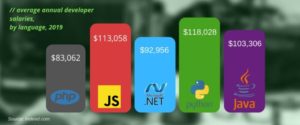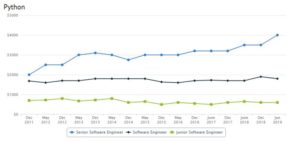It could safely be called an achievement day for Cathy, a recruiter at a middle-sized SaaS company located near a university town. As the newly employed Pythonist was heading home to start his job on Monday, she thought about the hunt. Not that there was a lack of specialists – what with the hype around the language. However, the most talented ones were lured from the in-house position she offered to the more “interesting” outsource projects – pushing the Python developer salary in the area upwards. This guy seemed to agree to settle with a considerable comfort package…
This story is only somewhat typical. With its vast array of applications, Python has become a huge thing, and circumstances vary enormously. Whatever the reason to employ Python professionals, businesses hire or outsource them en masse. According to the Stack Overflow survey among the users of the programming language, as many as 73.9% work full-time, indicating great demand.
In terms of language popularity, Python displayed the most striking growth in the Tiobe index by January 2019, gaining 3.62 points. In this article, we’ll dive into how this is reflected on Python developer salaries across the IT world – and what that means to enterprises.

So you need a Pythonist… How much?
Maybe you want a web application; maybe it’s a database-centered project or even machine learning – there appear to be plenty of situations where your company may need someone with Python skills.
Ever since its adoption by Google in 2004, Python has been pretty much in vogue, which is not a random thing. Programmer value it for a rich library, short and clean code – and clean code means tangible benefits for businesses. In terms of salary, this means there is a rift between the “just good old, unspecified” web developer salaries – averaging around $71,610 per year – and what a Pythonist may expect. With a mean annual $118,028 or so, Python developers are also more expensive than their PHP peers (who earn, according to Indeed.com, about $83,062 per year) – by almost 30%.

The figures that pop up on various ratings are, of course, only average numbers, as well. Further down, we will see the actual pay depend on a variety of factors, such as location, experience, and so on.
First, though, it’s worth to stop and look at what the noise is all about.
The triumph of the “snake”
Although Python may seem like a recent trend, the language itself is not as young. Designed by Guido van Rossum in 1990-91, it was relatively obscure until the mid-2000s. Some say the popularity began with the famous Django framework that made Python a good choice for web application development. Some hold Google responsible. The cold, hard fact is that by 2010s, there already was talk about PHP being a “dying language” soon to be pushed out by the young snake.
Besides (obviously) Google, here is the shortlist of companies and projects that use Python for widely different purposes:
- Instagram – the world’s biggest project using the Django framework, with business logic serving around 800 mln active users;
- Amazon – generally uses a bunch of languages, but the machine learning technology used for recommendations is said to be based on Python;
- Spotify – backend, and data analysis are in Python;
- Quora – values Python over PHP for flexibility and scalability; the open-source Tornado framework is used for live updates to the service;
- Facebook – 3rd used language here, with 21% of code – for purposes such as bridging network devices, server health checks, etc.;
- Netflix – according to the company themselves, use Python across the entire cycle run on AWS.
Besides these, Python is becoming the language of choice for many who deal with machine learning, pattern recognition, and generally with AI-related projects. No matter that Python developers, starting from the juniors, are aspiring to be in on the fun. In some locations, hiring one full-time in-house, 9 to 5, is a noticeable investment.
Ehm.. Outsource Python development? [Python salaries across the world]
Of course, even with a good pool of Python developers next door, many consider outsourcing them a good option. There are notable gaps between Python developer salaries across the world – as with any other language.
Here is, more or less, what you get in 2019, while googling what job sites like Glassdoor promise software engineers themselves – in the 7 most popular countries for IT outsource.
| Country | Average Python developer salary per month* |
| India | $1602 |
| Ukraine | $2300 |
| China | $3635 |
| Poland | $3039 |
| Philippines | $1931 |
| Brazil | $1927 |
| Thailand | $3273 |
*numbers come from different sources, all dated 2019; when given in local currency, converted to USD according to rates as of early October 2019.
The differences are striking; however, these are the average numbers that do not take into account the qualification or experience. This means, in a place where senior developers are abundant, the average rate is naturally higher than in a landscape dominated by juniors.
This means that you can actually predict where you are more likely to find more experienced specialists that demand more – and vice versa. If we take Ukraine as an example, the number above does not mean there are no other options. With the language being now studied by a large amount of university undergraduates, you can find junior Python developers (more than 1 year of experience) willing to work for $900 per month, as well as gurus that charge around $4500 but are capable of doing miracles.
Back to the payment gap, there are many other factors at play here: location within the country, the market competition, the “brand” of the country, etc. This brings us to the next question…
What level of experience do you expect right now?
As with other languages, Python developer wages differ according to skills and experience. Intriguingly, the gap between entry-level and senior Python developer salaries can be unexpected at times, and here is information about React developer salary. The average Python developer salary in the USA is reported at about $78,176 annually, and the figures for seniors are somewhere around $122,093 – which is approximately 56% more than the freshman’s pay. On the other hand, in Eastern Europe, things can be different. We have mentioned Ukraine, where the beginner gets around $12,000, and seniors $45,000 – which means that the junior Python developer salary is 417% less than that of gurus.
This has to do with IT education. In some countries, Python is included in the university curriculum, which accounts for a huge number of students with core Python qualifications in search of jobs. In the countries where Python knowledge is largely not part of formal ed (for example, India), developers learn Python at a later age, and thus have less experience, resulting in the generally lower average salary indicator, as the majority are less skilled.

The question to ask here is, what level of qualification is really required at the moment? This naturally depends on the project at hand. By now, the developer and business communities have come up with a sort of consensus as to what skills are considered “core” and thus primary, and what competencies are thought of as something more “advanced”.
|
Core Python skills – “default expected level” |
Nice-to-have, but NOT obligatory in juniors |
|
|
This can give you an idea of what the distribution should be in your ideal team, based on the nature of the work. At the same time, in some places, database management is considered mandatory, while front-end skills are not formally part of the core qualifications but many have them (e.g. those who started with JavaScript and then moved to backend). Everything that has to do with AI, ML, and neural networks is highly specific, and there are many senior developers who do not work in this field.
Finally, the thing to bear in mind is that the Python developer community is constantly expanding and its members learn a lot. This means that businesses should consider the current, not the theoretically desired level of proficiency while employing Python developers.
Nevertheless, it’s a normal practice for the top Python mobile app development agencies to employ developers who constantly update their skills.
The Python salaries dynamics
The PyPI (Popularity of Programming Language) index listed Python as the topmost studied language as far as online tutorials are concerned (25.95%). This means periodic influx of people willing to study Python across the world. The pattern is as follows: in a particular country, the language becomes popular due to either the high demand, unfilled niches or associations with lucrative fields such as AI. As the market becomes more saturated, the salary rift opens between the junior and the senior, with the less experienced developers averaging on a lower salary, and true connoisseurs becoming the elite of the community.
The following screenshot from dou.ua, a Ukrainian IT community resource, illustrates the trend quite well:

This, more or less, is also traceable in many countries, and is generally a good indicator for the employer, as it is easier to differentiate between the possible options – and be confident in the quality of the code.
At the end of the day… Worth it!
The periodic dramatic surges in Python salaries sometimes scare off potential employers and consultants. In reality, however, this language is about as cost-efficient as the other popular ones, and in many areas even more so. We have seen that once you analyze properly what exactly your organization needs, it becomes easier to navigate the (seemingly) complex landscape.
At the same time, Python itself grants some very tangible advantages due to its design. While it is mostly developers who praise the language the most, the benefits they cite can be easily translated into business opportunities.
- Third-party modules in PyPI
These allow the code written in Python to interact with many other languages and platforms, making Python almost universal in its scope of applications. With strong enough developers in the team, you can spare the effort of finding different HR for the next project. - Extensive standard library with high-order functions
As developers do not have to reinvent the wheel every time they need a piece of functionality in place, there are 2 important corollaries. First, the code becomes cleaner, and clean code means better maintainability, sparing the customer’s money in the nearest future. Second, the deliverable is produced faster, which means fewer working hours and more competitive deadlines for the project. Python has been named THE language for Rapid Application Development by a considerable portion of the project management community. - Strong integration with text processing capabilities and unit testing framework
Closely related to the previous point, this largely spares time and effort in development, QA and accelerates time-to-market. - Open Source and Community development
The language is free and thus has a large community of users who interact and exchange experiences – something that accounts for fast professional growth. IDEs like Spyder Python are also free to download. - Easy to learn
While this may seem something mostly interesting for programmers themselves, this accounts for a constant supply of junior developers to the market, who make the environment more competitive to the experienced developers and fill important gaps in the development process themselves. - Data structures
The in-built list and dictionary structures allow construction of structures fast at runtime. Also, there is the boon of dynamic data typing, which translates into less “explanatory” code – and fewer hours as the result. - Good for multi-protocol network applications
With its possibilities of control over processes, as well as object-oriented design, Python allows for excellent productivity in multi-protocol applications that surpass what the other languages can offer.

Generally, for businesses that want to employ a Python developer, it is important to analyze the exact purpose and arrive at a decision on the level required. Without this information, there is simply too much information that has to be sifted through and may seem contradictory at the first glance. In many cases, it is a good idea to consult specialists in the field. If outsourcing is the desired variant, professional agencies have in-house experts who can provide the necessary analysis and guidance for you to arrive at the most reasonable option out there.
